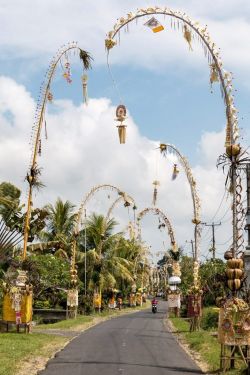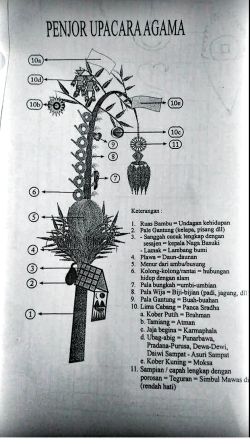Penjor
- Tiing ungkul maiyas ane jujukanga di lebuh umah duk ada upacara gede. ban
- offering consisting of a bamboo pole with decorations (Mider) en
- the body is a river that flows from the mountains to the sea en
- along its route are the products of the harvest, tied to the pole en
- at the foot of the pole is a temporary shrine. On the day before Galungan, Panampahan Galungan, every family is supposed to erect a penjor just outside his front gate. Each village or area has a distinctive style. en
- Decorated whole bamboo pole with flowers and agricultural produce which are stuck in front of a house or a temple during an important religious ceremony en
- the arched top represents Gunung Agung en
- bambu utuh dengan ujung melengkung yang dihiasi janur, berisi hasil bumi (sandang, pangan) yang dipergunakan dalam upacara (yadnya) (Mider) id
- hiasan berupa bambu (dari pangkal sampai ujung yang dihiasi dengan daun kelapa muda dan sebagainya (Mider) id

From "Penjor - Question Marks Against the Sky" by Susan Ruddy, NOW!Bali, Sept 3, 2020
The meaning of the penjor
“If you ask the nearest Balinese male about the symbolism of penjor, he will probably say, ‘I haven’t got a clue. Ask the women.’ The women will tell you to ask a priest. This is not to say that the men and women of Bali don’t know about penjor. They know very well when and how to make them, how to decorate them, how to make them stand up properly, and why they are important. But they hesitate to explain the symbolism, because the idea that there are correct answers to questions about “religion” in Bali is relatively new.”
So wrote Diana Darling, an American who has lived in and written eloquently about Bali for many years.
One of the most commonly held beliefs about penjor is that it is a symbol of Gunung Agung, the spiritual mountain in eastern Bali. It is the home of the gods and the ancestors, and is said by many to represent the holy Hindu Mount Mahameru, thus symbolising the entire universe. In this interpretation of the penjor’s meaning, the top is Agung’s peak, and the stem of the penjor, with all of its decorations, represents the rivers flowing down the mountainside, bringing the fullness of the earth to the people below.
Others, however, declare that the penjor represent powerful dragon deities called nagas. The Naga Anantaboga is a symbol of the earthly needs of humankind, while Naga Basuki represents water, prosperity and safety. According to the penjor-as-naga theory, the head of the naga is at the base of the penjor just above the small offering shrine called the Sangah Arda Cahndra. The tail of the naga is the graceful, slender tip of the penjor, and the scales of the dragon’s back are represented by the decorations which curve along the penjor’s back.
A penjor often is said to hold additional symbolic meanings. For instance, some say that the straight part of the bamboo represents the “good” in humans, while the curve represents the “bad” and thus must be decorated beautifully to compensate. Still others say that the curve of the penjor, with its back straight and its tip looking down to earth, is to remind people that, although they may have achieved a high status in life, they must never, ever, lose sight of their less fortunate fellow humans. The penjor’s downward-facing nature must always remind us of our common roots; we are all born of our mother’s womb, and this common origin confers on us a common responsibility for each other’s welfare.
I Gusti Nyoman Darta explained the significance of the downward curve of the penjor this way: “When I am young and studying, I am always crying ‘oh, I am very clever, very clever,’ but the more I study the more I think: ‘oh I am not so clever now.’ Then I keep what I already learn, and after I am already clever, I just look down like the penjor. When you are already clever enough, you do not speak much, and you are very, very clever. Just like the ripe rice. When it is coming ripe, then the rice in the middle gets heavy, and bends just like penjor.”The meaning of the penjor
“If you ask the nearest Balinese male about the symbolism of penjor, he will probably say, ‘I haven’t got a clue. Ask the women.’ The women will tell you to ask a priest. This is not to say that the men and women of Bali don’t know about penjor. They know very well when and how to make them, how to decorate them, how to make them stand up properly, and why they are important. But they hesitate to explain the symbolism, because the idea that there are correct answers to questions about “religion” in Bali is relatively new.”
So wrote Diana Darling, an American who has lived in and written eloquently about Bali for many years.
One of the most commonly held beliefs about penjor is that it is a symbol of Gunung Agung, the spiritual mountain in eastern Bali. It is the home of the gods and the ancestors, and is said by many to represent the holy Hindu Mount Mahameru, thus symbolising the entire universe. In this interpretation of the penjor’s meaning, the top is Agung’s peak, and the stem of the penjor, with all of its decorations, represents the rivers flowing down the mountainside, bringing the fullness of the earth to the people below.
Others, however, declare that the penjor represent powerful dragon deities called nagas. The Naga Anantaboga is a symbol of the earthly needs of humankind, while Naga Basuki represents water, prosperity and safety. According to the penjor-as-naga theory, the head of the naga is at the base of the penjor just above the small offering shrine called the Sangah Arda Cahndra. The tail of the naga is the graceful, slender tip of the penjor, and the scales of the dragon’s back are represented by the decorations which curve along the penjor’s back.
A penjor often is said to hold additional symbolic meanings. For instance, some say that the straight part of the bamboo represents the “good” in humans, while the curve represents the “bad” and thus must be decorated beautifully to compensate. Still others say that the curve of the penjor, with its back straight and its tip looking down to earth, is to remind people that, although they may have achieved a high status in life, they must never, ever, lose sight of their less fortunate fellow humans. The penjor’s downward-facing nature must always remind us of our common roots; we are all born of our mother’s womb, and this common origin confers on us a common responsibility for each other’s welfare.
I Gusti Nyoman Darta explained the significance of the downward curve of the penjor this way: “When I am young and studying, I am always crying ‘oh, I am very clever, very clever,’ but the more I study the more I think: ‘oh I am not so clever now.’ Then I keep what I already learn, and after I am already clever, I just look down like the penjor. When you are already clever enough, you do not speak much, and you are very, very clever. Just like the ripe rice. When it is coming ripe, then the rice in the middle gets heavy, and bends just like penjor.”A: Niki ampun puput niki. Q: Nggih A: Kanggeang. Sawentene
Q: Nggih.A: I'm already finished here. Q: I see. A: Please don't be offended with the result. We have to do with whatever we can find here.
Q: I understand.A: Ini sudah selesai ini. Q: Iya. A: Berkenanlah diterima. Seadanya
Q: Iya.
No translation exists for this example.





